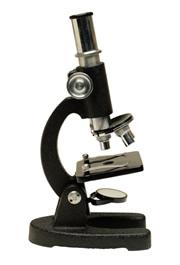 A clever magnifying glass under the microscope can turn the very tiny visible.Getty
A clever magnifying glass under the microscope can turn the very tiny visible.GettyMicroscopes have been fitted out with spectacles that give them better vision than ever before.
Two teams of researchers in the United States have made 'superlenses' that boost the acuity of optical microscopes beyond that normally permitted by the laws of physics1,2.
These accessories are among the first practical products of the new science of 'metamaterials': materials built from carefully crafted components, rather as a building is made from bricks, glass and steel.
Many of the most exciting uses of metamaterials are in optics: controlling the flow of light. They can, for example, bend and refract light in ways that no ordinary material can (see 'Materials science: Unexpected tricks of the light ').
A metamaterial with a negative refractive index, meaning that light passing through it bends the opposite way to what is normally expected, was reported six years ago3. And last year, researchers used the light-bending properties of metamaterials to make the first stages of an 'invisibility cloak' that guides light rays around a region of space and then brings them together again at the other side — though not, unfortunately, when using visible light4.
One of the architects of that work, physicist John Pendry of Imperial College in London, proposed in 2000 that metamaterials could be used to make a 'superlens' that could focus light more tightly than is normally possible5. Light microscopes cannot generally image objects much smaller than the wavelength of light (several hundred nanometres) because of wave-interference effects; but Pendry showed that a superlens could reveal details considerably smaller than this.
But so far, most metamaterials have worked only at much longer wavelengths than visible light — in the microwave region. This is because the size of the individual components of the metamaterial must be comparable to the wavelength of light they manipulate. It is hard to make components small enough to influence visible light.
Now, however, two teams led by Xiang Zhang at the University of California at Berkeley and Igor Smolyaninov at the University of Maryland have independently cracked the problem.
Wheels within wheels
Zhang's superlens is a half-cylinder made of concentric, 35-nanometre-thick shells of silver and aluminium oxide. The structure acts as a magnifying glass that expands the image of an object placed within it, so that it can then be distinguished using a conventional microscope lens. Zhang and colleagues show that this system can be used to make out two narrow lines just 100 nm apart, and can read the letters 'O' and 'N' in characters about 400 nm wide. To an ordinary microscope, these would just be a blur.
ADVERTISEMENT
The superlens made by the Maryland team also magnifies an object so that it can be seen with a conventional microscope. But the design is rather more complex. It consists of concentric semicircles of a polymer laid down on a gold film. To see a row of polymer dots inside the innermost semicircle, the sample is illuminated with light. This excites waves of electrons, called plasmons, in the gold film, which radiate into the superlens structure and produce an enlarged image of the dots. The researchers say that dots just 70 nm apart can be distinguished.
Superlenses like this might allow biological objects such as individual viruses or molecules of DNA to be imaged — something that once seemed inconceivable with optical microscopy. "There's a huge amount of potential in this area," Pendry says.
Visit our bringthe_nanoworl.html">newsblog to read and post comments about this story.
-
References
- Liu Z., et al. Science, 315 . 1686 (2007).
- Smolyaninov I I., et al. Science, 315 . 1699 - 1701 (2007).
- Shelby R. A., et al. Science, 292 . 77 - 79 (2001). | Article | PubMed | ISI | ChemPort |
- Schurig D., et al. Science, 314 . 977 - 980 (2006). | Article | PubMed | ChemPort |
- Pendry J. B.. Phys. Rev. Lett., 85 . 3966 - 3969 (2000). | Article | PubMed | ISI | ChemPort |
